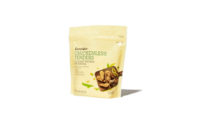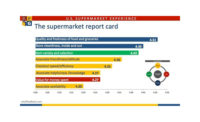Wegmans, Trader Joe's, Publix and Fareway are among the nation’s Top 52 major grocery stores, according to aConsumer Reports study.
Wegmans, Trader Joe's, Publix and Fareway are among the nation’s Top 52 major grocery stores, according to aConsumer Reports study. The survey also revealed that even some of the high-rated chains gave plenty of shoppers something to complain about.
Of the 24,203 readers who toldConsumer Reportsabout 42,695 supermarket experiences, more than half had at least one complaint about their current store; almost a third cited two or more.
One-third of subscribers surveyed said they had given the heave-ho to a nearby grocery store. Forty-three percent changed their grocer in search of lower prices; about 25% cited poor selection, long lines or lousy food; 17% blamed employee rudeness and 14% didn’t like the crowds.
The biggest gripe overall: Not enough open checkouts (cited by 27% of shoppers), followed by congested or cluttered aisles and advertised specials that were out of stock. Other irritants included inept bagging, missing prices and scanner overcharges.
No chains tried their customers' patience more than Walmart Supercenter, Pathmark (Northeast) and Pick 'n Save (Wisconsin), where roughly three-fourths of shoppers had one or more problems. Shoppers who frequented Walmart complained about being miffed about the lack of open checkouts, out-of-stock regular items, indifferent employees, spotty pricing and confusing store layout. Thirteen percent of respondents shopping at Pathmark said they'd been overcharged, almost twice the average rate inConsumer Reportssurvey.
Fortunately, most consumers have several shopping choices, and some supermarkets gave customers much of what they want. Costco, Trader Joe's, Fareway Stores (Midwest) and Wegmans offer quality meat and produce, a clean shopping environment and very good or exceptional prices. All but Costco even earned the highest possible marks for service, defined as employee courtesy and checkout speed. Service is minimal at warehouse clubs such as Costco, and lengthy lines are a trade-off for day-in, day-out deals.
Smart shoppers can slash bills by 60%
Also in the report,Consumer Reportsfound that shoppers can save hundreds, even thousands of dollars a year by doing a little homework and adjusting shopping habits.Consumer Reports' shopping expert Tod Marks cut his bill by as much as 60% on a market basket of 20 everyday products by using different shopping strategies. First he impulse-shopped, costing $164.28 for all 20 items.
He pared the cost of the same list to $93.12 as a savvy-store shopper using coupons, saving-club cards, eyeing weekly flyers and other techniques. As a warehouse-club shopper, he trimmed his expenses even further to $67.64. But as a store brand fan, Marks was able to fill his cart with all 20 items for $66.23-almost 60% cheaper than his original impulse shopping trip.
Avoid store traps designed to make shoppers spend more
Supermarkets are giant selling machines in which traffic patterns, product placement displays and smells encourage shoppers to open their wallets.Consumer Reports’ latest study offers advice to resist both the hard and soft sell:
• Sneaky sales signs. The sign reads "5 for $5," the implications being you need to purchase the entire amount to get the discount. But rarely are you required to do so. Retailers are just planting a number in your head, hoping you'll buy a lot.
• Shop against the grain. Most stores have their main entrance on the right side, and their customers tend to shop counter-clockwise. When researchers compared those shoppers with people who went through a left entrance and shopped clockwise, they found the clockwise folks spent $2 less per trip, on average.
• Bump-outs, end-caps.Beware of "bump-outs," displays and shelves that curve or jut out. They catch the eye and make merchandise prominent. When you reach the end of an aisle, don't assume the merchandise is always on sale. Stores routinely reset end-caps and other high-profile displays with sale items the day before the lower price takes effect.
• Look high and low.Supermarkets are in the real-estate business, and prime selling space includes the middle or eye-level shelving. Vendors sometimes pay retailers hundreds, even thousands, of dollars in slotting fees to take on new products or display products prominently. Check whether similar products on top or bottom shelves are less expensive.
• Front loading the veggies and fruits. The produce department is usually near the entrance, and there's a savvy strategy behind the location. In addition to imparting the message that "this is a fresh, healthy place," that placement gives shoppers license to buy cake and ice cream as a reward for picking up a head of broccoli or bag of apples.
• Be wary of the "9s."Do not be fooled if the price ends in "9." It's a practice known as "charm" pricing. Some researchers believe that shoppers see a jar of peanuts priced at $6.99 as $6 rather than $7, making it seem cheaper. Buyers have also been conditioned to associate prices ending in "9" with a bargain.
Complete grocery store ratings on all 52 national and regional chains, more tips to save and more on the latest traps and store trends are available in theConsumer Reports May 2012 issue or online at www.ConsumerReports.org.
Get our new eMagazine delivered to your inbox every month.
Stay in the know on the latest food and beverage manufacturing markets.
SUBSCRIBE TODAYCopyright ©2024. All Rights Reserved BNP Media.
Design, CMS, Hosting & Web Development :: ePublishing

